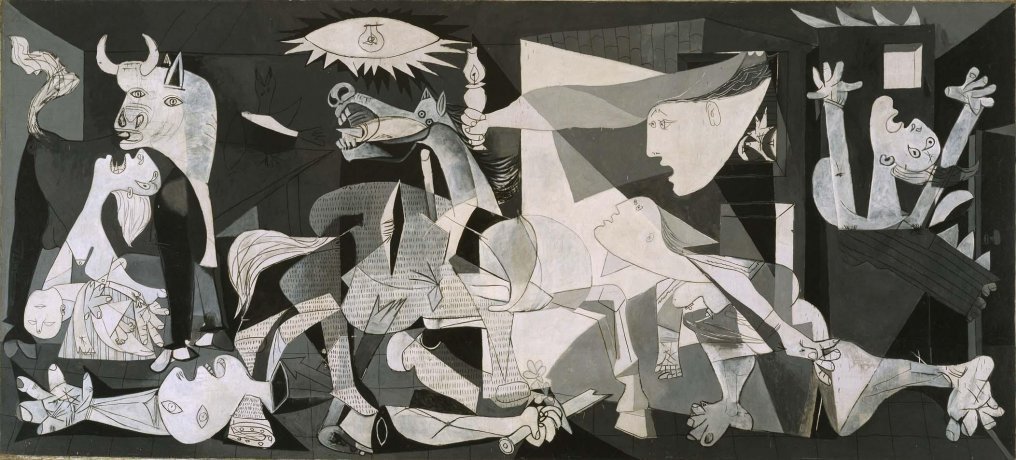At 11 feet tall and 25 feet long, Pablo Picasso´s mural Guernica is one of the biggest and most important works by the modernist master. But the work has been considered more than just a treasure of art history by many. Painted in response to the bombing of a Basque town in 1937, Guernica has also become a powerful symbol of the horrors of war for protesters around the world. The guide below examines the mural’s history, including its 42-year-long sojourn in the United States, its role in Vietnam War protests, its legendary defacement in 1974, and its storied first exhibition in Spain in 1981.
The painting was created for the 1937 World’s Fair in Paris.
Guernica was completed between May and June 1937 to be exhibited at the International Exposition in Paris that same year. The work was exhibited in the Spanish Pavilion, which was designed by the architect Josep Lluís Sert, alongside pieces by Alexander Calder and Joan Miró. Picasso took up the Nazi aerial bombing of the ancient Basque town of Guernica in April 1937 as the subject for the mural. Though historians believe Picasso’s engagement with newspaper reports and photographs of the events in Guernica influenced the content of the mural, the painting, which depicts splayed bodies and horrified faces, features no specific allusions to the event. The work is widely understood to represent the universally catastrophic toll of war.
Guernica traveled to the United States two years later.
Following a European tour that did not include an exhibition in Spain, Guernica was sent to the U.S. as part of an effort to raise funds for the Spanish Refugee Relief Campaign. Its first stop was New York, where it was put on view at the now-defunct Valentine Gallery in 1939. It then visited Stendhal Gallery Los Angeles, the San Francisco Museum of Art, and the Chicago Arts Club before returning to New York for a Museum of Modern Art Picasso retrospective. Over the next year, that show traveled to major museums in Boston, Chicago, Cleveland, New Orleans, Pittsburgh, San Francisco, and St. Louis.
The masterpiece received mixed reviews in the U.S.
The New York World Telegram was the first American publication to print a large-scale reproduction and description of Guernica in 1937, two years before its arrival in the U.S. The article about the painting called Guernica “incomprehensible to most people who see it.” A 1939 review in the Springfield Republican stated that a viewing of the painting is “a half-dollar well spent, for it symbolizes the passage from isolation to social identification of the most gifted painter of our era.”
With the outbreak of World War II, Picasso requested that MoMA safeguard Guernica.
The artist requested that MoMA keep Guernica when war once again took hold in Europe in 1939. Guernica was displayed at Harvard University’s Fogg Museum on two occasions in the early 1940s, and it was also exhibited at other institutions in the United States. In the early and mid-1950s Guernica traveled to Milan, São Paulo, Paris, Munich, Cologne, Stockholm, Brussels, and Amsterdam. The mural and some 95 other pieces that Picasso loaned for the 1939 retrospective remained under MoMA’s stewardship through 1958, when it staged the show “Picasso: 75th Anniversary.” Following that exhibition, Picasso requested that Guernica and its preparatory drawings stay at MoMA on indefinite loan until Spain installed a democratic government.
Ad Reinhardt drew a cartoon about Guernica for a leftist publication.
In 1947, the artist Ad Reinhardt created a cartoon published in P.M., an American publication known for its left-wing politics. For an article called “How to Look at a Mural,” Reinhardt examined and explicated various elements from Guernica, including the bull, the contorted limbs, and the shrieking mother. The spread in P.M. might be understood as an attempt on Reinhardt’s part to convey the mural’s significance. He writes in the introductory text accompanying the illustration that the work is not “a simple poster or banal political-cartoon which you can easily understand (and forget) in a few minutes, but a design that diagrams our whole present dark age.”

Guernica became an enduring protest symbol during the Vietnam War.
When the Vietnam War broke out, Guernica was seen anew by activists. The Art Workers’ Coalition, an art-world group that decried U.S. colonialism and racism, put the painting on posters created in the 1960s and 1970s, one of them bearing the phrase “Stop the war in Vietnam now!,” along with a detail of a slain man in Picasso’s mural. In 1970, following the 1968 My Lai Massacre in Vietnam, the Art Workers’ Coalition demanded in an open letter signed by prominent art-world figures—including artists Louise Bourgeois, Donald Judd, and Robert Smithson—that Picasso remove the work from the Museum of Modern Art. The missive stated that “the continuous housing of Guernica in the Museum of Modern Art, New York, implies that our establishment has the moral right to be indignant about the crimes of others—and ignore our own crimes.” In recent years, the work has become a symbol for protesters in Rome, Barcelona, and other locations around the world.
The masterpiece was vandalized a year after Picasso’s death.
One year after Picasso’s death, Guernica sustained an attack while on view at MoMA. The artist and activist Tony Shafrazi, who later became known as a dealer of works by giants like Jean-Michel Basquiat, Keith Haring, Andy Warhol, and Francis Bacon, spray painted the phrase “Kill Lies All” on the mural in February 1974. “I’m an artist and I wanted to tell the truth,” Shafrazi told the New York Times the day of the incident. Shafrazi was arrested at the scene and later charged with “criminal mischief,” according to the Times‘s report. The painting was not permanently damaged.
Guernica‘s first public exhibition in Spain drew major crowds.
Having been on loan to the Museum of Modern Art in New York for 42 years, Guernica finally made its way to Spain in 1981. It was headed to the Casón del Buen Retiro, an annex of the Museo del Prado in Madrid, where it went on public view—for the first time in Spain—on the 100th anniversary of Picasso’s birth, and it remained there until 1992, when it officially entered the collection of the Museo Reina Sofía. Along with its preparatory drawings, Guernica is now displayed in a gallery dedicated to art associated with conflict.



Comment here